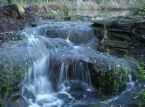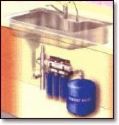

MENTION THE LINK FOR
MORE INFO ON RO WATER http://ajwaterpurificationplus.50webs.com
http://www.ehso.com/ehshome/DrWater/drinkingwater.php
There
are several different varieties of bottled water. The product may be labeled as
bottled water, drinking water or any of the following terms. The Food and Drug
Administration's (FDA) product definitions for bottled water are:
Artesian Water / Artesian Well Water: Bottled water from a well that
taps a confined aquifer (a water-bearing underground layer of rock or sand) in
which the water level stands at some height above the top of the aquifer.{ A water-bearing formation of gravel, permeable rock, or
sand that is capable of providing water, in usable quantities, to springs or
wells. Aquifers are important reservoirs storing large amounts of water
relatively free from evaporation loss or pollution
}
Distilled water is water that has virtually all of its
impurities removed through distillation. Distillation involves boiling the
water and re-condensing the steam into a clean container, leaving most if not
all solid contaminants behind ( and then there is double distlled to get
anything left over by the first distillation)
Drinking Water: Drinking water is another name for bottled water.
Accordingly, drinking water is water that is sold for human consumption in
sanitary containers and contains no added sweeteners or chemical additives
(other than flavors, extracts or essences). It must be calorie-free and
sugar-free. Flavors, extracts or essences may be added to drinking water, but
they must comprise less than one-percent-by-weight of the final product or the
product will be considered a soft drink. Drinking water may be sodium-free or
contain very low amounts of sodium.
Mineral Water: Bottled water containing not less than 250 parts per
million total dissolved solids may be labeled as mineral water. Mineral water
is distinguished from other types of bottled water by its constant level and
relative proportions of mineral and trace elements at the point of emergence
from the source. No minerals can be added to this product. ( the debate here is whether you
can actually absorb these minerals or do the accumulate in the system and cause
health dysfuntions)
Purified Water: Water that has
been produced by distillation, deionization, reverse osmosis or other suitable
processes and that meets the definition of purified water in the United States
Pharmacopoeia may be labeled as purified bottled water. Other suitable product
names for bottled water treated by one of the above processes may include
"distilled water" if it is produced by distillation, "deionized
water" if the water is produced by deionization, or "reverse osmosis
water" if the process used is reverse osmosis. Alternatively
"_____________ drinking water" can be used with the blank being
filled in with one of the terms defined in this paragraph (e.g. "purified
drinking water" or "distilled drinking water").
Sparkling Water: Water that after treatment and possible replacement
with carbon dioxide contains the same amount of carbon dioxide that it had at
emergence from the source. (An important note: soda water, seltzer water and
tonic water are not considered bottled waters. They are regulated separately,
may contain sugar and calories, and are considered soft drinks.)
Spring Water: Bottled water derived from an underground formation from which
water flows naturally to the surface of the earth. Spring water must be
collected only at the spring or through a bore hole tapping the underground
formation and the spring. Spring water collected with the use of an external
force must be from the same underground stratum as the spring and must have all
the physical properties, before treatment, and be of the same composition and
quality as the water that flows naturally to the surface of the earth. { again
the debate is, does the mineral content actually get used or stored in te
system, not to mention bacterial or microbial contaminants}
Well Water: Bottled water from a hole bored, drilled or otherwise
constructed in the ground which taps the water of an aquifer.
Reverse Osmosis

Drinking water purification
systems, including a reverse osmosis step, are commonly used for improving
water for drinking and cooking.
Such systems typically
include four or five stages:
In some systems, the
carbon pre-filter is omitted and cellulose
triacetate membrane (CTA) is used. The CTA membrane is prone to rotting
unless protected by the chlorinated water, while the TFC membrane is prone to
breaking down under the influence of chlorine. In CTA systems, a carbon
post-filter is needed to remove chlorine from the final product water.
Portable reverse osmosis
(RO) water processors are sold for personal water purification in various
locations. To work effectively, the water feeding to these units should best be
under some pressure (40psi or over is the norm). Portable RO water processors
can be used by people who live in rural areas without clean water, far away
from the city's water pipes. Rural people filter river or ocean water
themselves, as the device is easy to use (Saline water may need special
membranes). Some travelers on long boating trips, fishing, island camping, or
in countries where the local water supply is polluted or substandard, use RO
water processors coupled with one or more UV sterilizers. RO systems are also
now extensively used by marine aquarium enthusiasts, as the domestic water
supply contains substances that are extremely toxic to most species of
saltwater fish. In the production of bottled mineral water, the water passes
through a RO water processor to remove pollutants and microorganisms, In
European countries, though, such processing of Natural Mineral Water (as
defined by a European Directive) is not allowed under European law.(In
practice, a fraction of the living bacteria can and do pass through RO
membranes through minor imperfections, or bypass the membrane entirely through
tiny leaks in surrounding seals. Thus, complete RO systems may include
additional water treatment stages that use ultraviolet
light or ozone
to prevent microbiological contamination.)
In the water treatment
industry there is a chart of types of contaminants, their sizes and which ones
pass through the various types of membranes.[1]
Membrane pore sizes can vary from 1 to 50,000 angstroms
depending on filter type. "Particle filtration" removes particles of
10,000 angstroms or larger. Microfiltration
removes particles of 500 angstroms or larger. "Ultrafiltration"
removes particles of roughly 30 angstroms or larger. "Nanofiltration"
removes particles of 10 angstroms or larger. Reverse osmosis is in the final
category of membrane filtration, "Hyperfiltration," and removes
particles larger than 1 angstrom
What is
water really supposed to do? Hydrate and
cleanse and be utilized by the system to allow fluids in our cells to work
properly. The concept of drinking a gallon a day is totally ridiculous…..if you
are consuming fruits veges , drinking herbal teas, making juices this is all
part of the process of maintaining hydration….the environment you are in,
determines you’re requirements of water, the hotter or more toxic you’re
environment then the more you will need to maintain hydration by drinking, the
more wet the environment the less you will need and the cleaner the environment
will be based on your activity levels. But in all levels you do not want
contaminated water, and a good RO system is probably the best solution for most
unless you live over an aquifier . it will remove all contaminants up to 98% .
It will also deal with bacterial and microbial to a certain level depending on
the type of system you are using, and the style of membranes. If you are in a
desert you might want to combine an RO system with a Atmosperic water generator,
if you live near a body of salt water, this would definitely insure your levels
of adequate drinking water that is fresh and salt and contaminant free
An Atmospheric water generator (AWG), or
atmospheric condenser, is a developing piece of technology with the intent of
producing pure drinking water from the humidity of the
surrounding air. An AWG operates in a manner very similar to that of a
refrigerated dehumidifier: air is passed through a cooled coil,
causing water to condense. The amount of water that can be produced depends on
the humidity, the volume of air passing through the coils, and the size of the
machine.
The device is used in situations where pure
drinking water is otherwise difficult to obtain or where the population demands
are greater than the water tables can sustain or the water table has been or is
contaminated, or for natural disaster relief.
Basic
operating principle of an AWG
An AWG uses refrigeration
techniques optimized to condense water from air. Blower driven air is drawn
into the system through an electrostatic filter. In the machine's exterior
housing, a compressor
circulates refrigerant through a coil array located in the path of
the air providing a temperature differential between the air and coil surface,
resulting in condensation. The condensation is funneled into a holding
tank. A level switch in the holding tank controls the water making cycle. Water
is pump circulated in an ozone generating UV light
chamber to kill bacteria
and then through high and low density charcoal
filters to remove solids and oxygenates. It is finally collected back in
the holding tank. The water filtration cycle is both flow and time
controlled. Water is dispensed by tap valve diversion. The actual amount of
water produced depends on relative
humidity and ambient air temperature. Relative humidity measures the amount
of water vapour present in the air at a given temperature. The higher the
relative humidity and air temperature, the more effective most all of these
devices are. Typically these refrigeration-based devices do not work
efficiently when the temperature gets below 15.5°C (60°F) or the relative
humidity drops below 30%.
A wide range of Atmospheric generators are
available, from a home/office unit producing 28 litres a day, to 1200 litres
and even more than 500.000 litres per day for industrial bottling plants.
The cost effectiveness of an atmospheric water
generator depends on the capacity of the machine as well as on humidity and
temperature conditions. Besides such machines can be powered by alternative
energy like solar, wind or even gas or oil fired generators which can be of
great help especially when such machines are put into operation for relief
efforts.
The following is the cost per liter
calculation for a typical 120 litres per day AWG with power consumption 2.6kW @
INR(Indian Rupee) 4.5 per kWh.The cost of producing 1 liter
of water will typically range from $US0.03 (85-100% RH)
to $US0.06 (40-50% RH)Total
annual electric costs : 2.6kW × 24 hrs/day × 365
days/year ×INR 4.5 per kWh = Rs.1,02,492/year ≈ US$2,277.60/year (US$1 =
INR45).......A total annual water
production : 120 litres per day × 365 days/year =
43,800litres/year..........B
COST PER LITER = A
÷ B = US$0.05
The methods listed below are not AWGs
but other alternative methods of water making.
Source: LexCarb LLC
Source: Sciperio Inc.